
Product test
The Mova P50 Pro Ultra is everything a robot vacuum cleaner should be
by Lorenz Keller

When I tested the Ecovacs Deebot X9 Pro Omni, I was dealing with a robot vacuum with a roller instead of mops for the first time. My conclusion: this technology has potential!
You know the symbolic image of human evolution with an ape walking on all fours on the left and an upright human on the right? Robot vacuum cleaners are currently undergoing a similar evolution when it comes to wet cleaning.
First, they dragged a rag across the floor – which had to be cleaned by hand. Then came vibrating plates. Now, most models have round mops that rotate and are automatically cleaned in the base station.
I was able to test the next step in its evolution for the first time with the Ecovacs X9 Pro Omni. Instead of round mops, it has a roller with a fabric cover for mopping.
There’s a mounted roller at the rear of the robot, which rotates rapidly during cleaning. The Ecovacs X9 Pro Omni dampens the fabric cover on one side and drains the dirty water from the other. This means the robot has built-in fresh water and waste water tanks. It works like the wet/dry vacuum cleaners you push around by hand. My colleague Simon tested one recently.
At regular intervals, the robot returns to the base station, where the roller’s washed with water at up to 75 degrees Celsius. A hairdryer then dries the roller with hot air at over 60 degrees Celsius. Ecovacs does almost all the work for you. All you have to do is clear dust and hair residue from the washing station every few months.
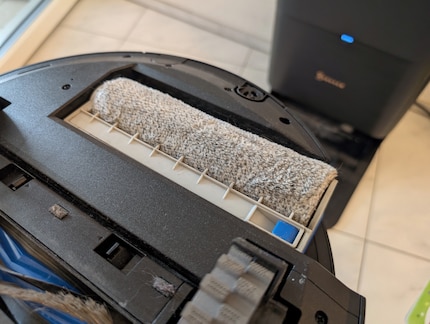
The roller’s 19 centimetres wide, allowing it to clean a strip approximately 20 centimetres wide in one sweep. The robot can also extend the roller to one side to clean edges better.
Manufacturers put forward two arguments why the future belongs to rollers and cylinders.
How do these advantages translate into everyday testing? At first glance, they’re smaller than expected – but on closer inspection, they’re definitely noticeable. The Ecovacs X9 Pro Omni leaves rooms clean: dust, particles, small stains – it’s all gone. I sent the robot out several times a week, which significantly improved basic cleanliness. However, mid-range devices with two round mops – such as the Mova P50 Pro Ultra – can now also do this.
The Ecovacs with a roller shows its strengths in the details: it really cleans wherever it goes. It easily removes dried droplets on the first pass. Other models often leave them visible after a normal clean. This is where the higher pressure pays off.
However, the Ecovacs Deebot X9 Pro Omni doesn’t perform miracles either, as the extreme test shows. I spread tomato sauce on the floor and let it dry. While the robot cleans up quite a lot of it, the stain is still clearly visible. Unfortunately, the system doesn’t detect the heavy soiling and doesn’t clean again.
Even worse, it’s spreading tomato sauce because it just keeps going. The amount of dirt has pushed the self-cleaning system to its limits, and part of the cover’s stuck. I have to stop the robot vacuum and clean around the roller by hand.

Nevertheless, my overall impression’s a positive one. The roller’s more effective at detailed work than systems with two rotating, round mops, but the X9 Pro Omni doesn’t come close to the performance of a good wet/dry vacuum cleaner.
The roller takes up about ten per cent of the robot’s housing. That’s significantly more space than the mops, which are more or less just attached. Nevertheless, the 98-millimetre height is within the normal range. Many competing models are between nine and ten centimetres high. If you have sofas or beds with less space underneath, you’ll need to look for a slimmer model.
I also don’t have to make any noticeable compromises in terms of dust container or battery size. The robot doesn’t return to the base station to empty the former more often than other models. And the battery capacity is more than enough to clean a 120m2 four-and-a-half-room apartment with in one go.
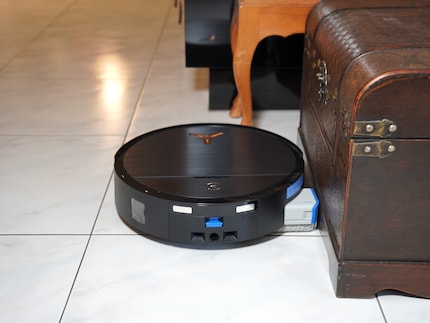
Carpet fans are likely to face the biggest challenge. Models with mops can store them in the base station when vacuuming carpets, preventing wet mops being dragged across them. With the Deebot, the roller stays in place. Ecovacs addresses the carpet problem with two measures: the robot raises the roller and always vacuums the carpets first before dampening the roller for mopping.
This wasn’t a problem in my test, as I only have a small rug in the bathroom. The Ecovacs recognised and marked it during the map creation process, and it always stayed dry. Nevertheless, a model with a roller might not be the first choice for anyone with a lot of carpet at home.
As a robot vacuum, the Deebot proved itself in all areas during my six-week test. It is, however, noticeably slow, starting with the mapping process. The X9 Pro Omni takes 14 minutes to cover approximately 120 square metres. Only the Roborock models are slower. But that’s not so bad, because you only have to do it once.
The resulting floor plan being accurate is much more important – and this one is. I just have to separate the living room from the open kitchen and the second bathroom from the hallway and I’m ready to go. What’s striking is that – unlike most other manufacturers – Ecovacs displays a schematic representation of the apartment. Other models show outlines of the furniture against the wall, and every nook and cranny’s precisely depicted.
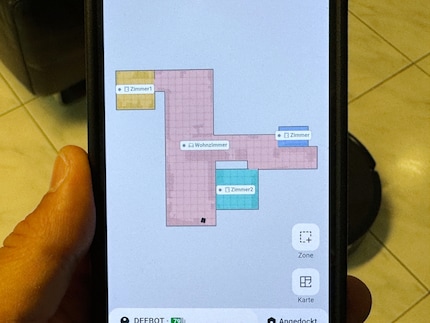
However, I didn’t notice any impact on navigation. The robot finds its way around easily and cleans exactly what it’s supposed to. Incidentally, Ecovacs doesn’t use a tower for sensors, lasers or cameras. They’re integrated. Images for obstacle detection, for example, are processed locally on the device, so image data’s not uploaded to the cloud. Unless you explicitly authorise this in the app for the Product Improvement Plan or use the integrated camera via the app for a live view of your home.
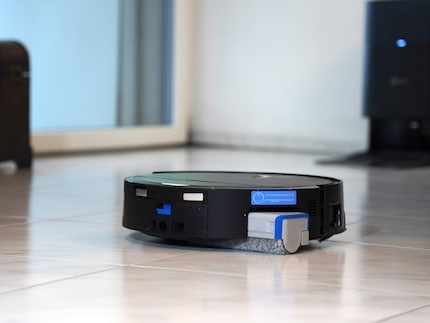
Overall, the robot’s more of a conscientious snail than a racehorse. During a standard clean – including mopping and vacuuming – it takes about one minute per square metre. However, this only bothered me when I was pressed for time, such as when I wanted the robot to do a quick pass of the kitchen before dinner.
I’d rather not hear any suction noise during mealtimes. The X9 Pro Omni isn’t exactly quiet. At 63 decibels – measured from about one metre away – it’s in the upper mid range in terms of noise levels.
What stands out in a good way, however, is the anti-tangle brush. Even after six weeks of testing, not a single hair got tangled around it – despite two people at home with long hair.
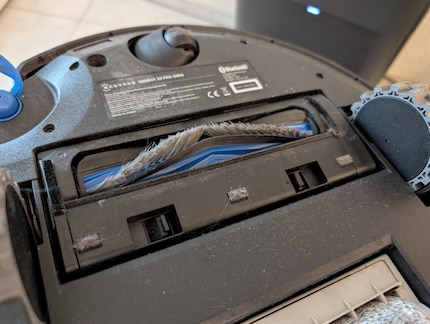
Ecovacs lacks one feature entirely, which is included in the current top models from Roborock and Dreame. The X9 Pro Omni can’t climb. If you have thresholds or steps more than one or two centimetres high in your home, you’ll need to build ramps or look into the competition.
The X9 Pro Omni may not yet be the intelligent homo sapiens in the evolution of mop technology, but it’s taken a big step forward.
The Ecovacs Deebot X9 Pro Omni’s one of the first robot models on the market to operate like a wet/dry vacuum, with a continuously moistened cloth roller cleaning the floor.
This means the X9 Pro Omni cleans up more effectively than many competitors which rely on mops – especially when it comes to stains or stubborn dirt. Since the roller can’t be detached, it’s less suitable for households with lots of carpets. It also lacks a climbing function, which many competitors in the above 1,000 franc price bracket already have.
Pro
Contra
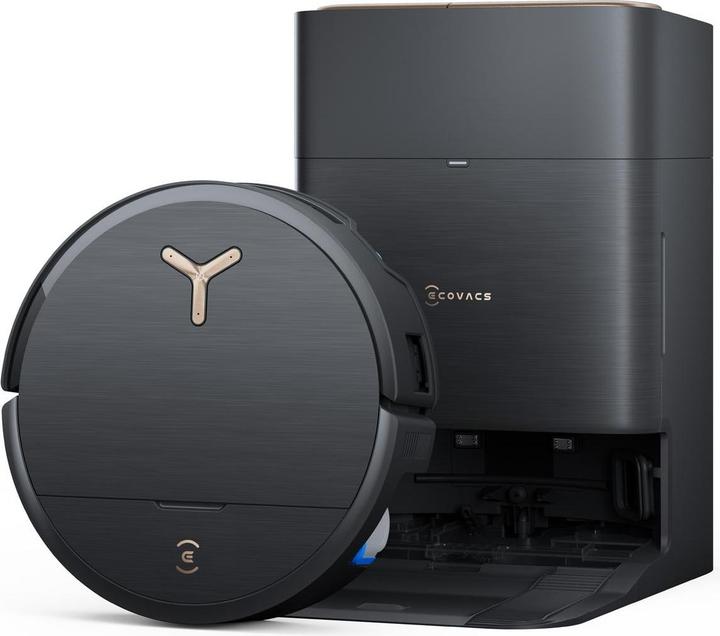
Ecovacs X9 Pro Omni
16600 Pa, Mop roller
Gadgets are my passion - whether you need them for the home office, for the household, for sport and pleasure or for the smart home. Or, of course, for the big hobby next to the family, namely fishing.